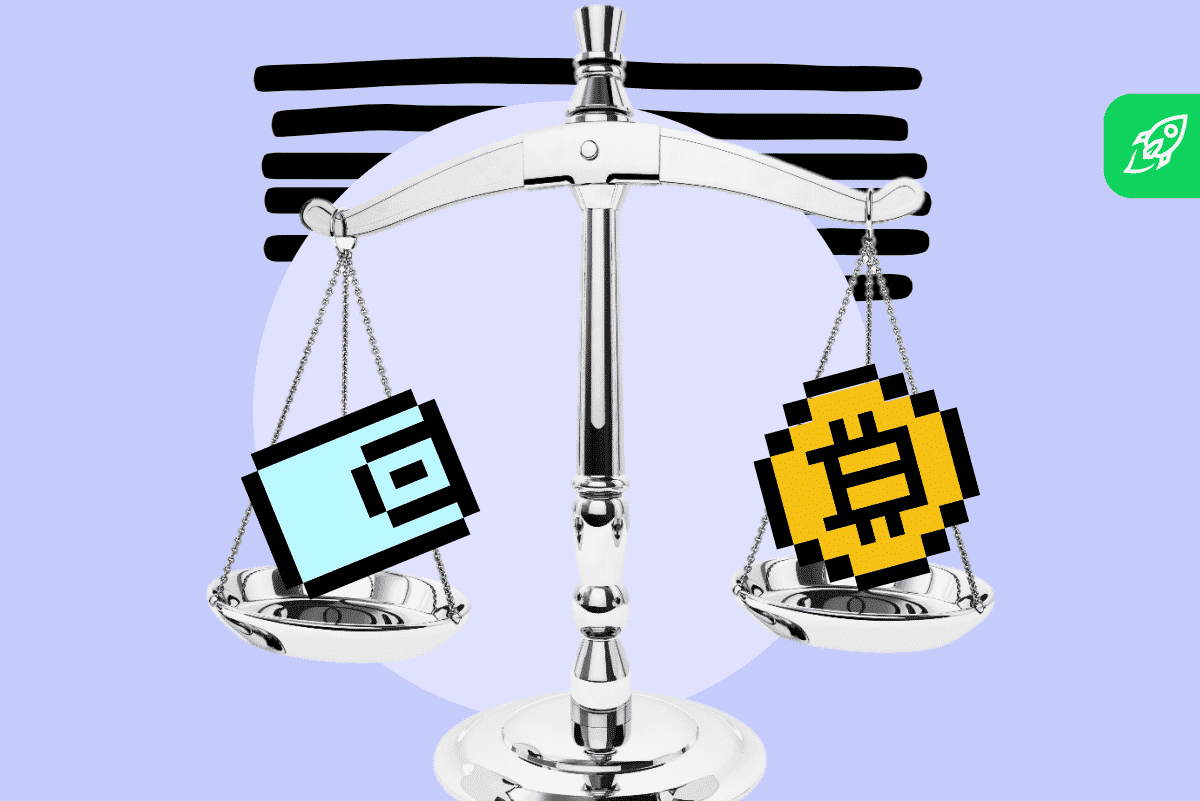intermediate
The technology behind Bitcoin and Ethereum is groundbreaking and has opened up many potential uses. However, some characteristics make them difficult to use as a replacement for fiat currencies on a day-to-day basis: their notorious volatility.
Stablecoins are referred to as the “holy grail” of cryptocurrencies. They satisfy a need that cryptocurrencies have not been able to meet so far, the desire for price stability. But why is this so important, and why is it so difficult to implement?
What Is a Stablecoin?
For a trader, volatile cryptos are good as they can allow larger profit margins. For an investor looking for a currency to store value, this is a significant disadvantage. In addition to the high transaction fees, this is also one of the main reasons why many companies do not accept currencies such as Bitcoin as a means of payment. When a currency fluctuates within a few hours, it is difficult to use it as a means of payment.
Stablecoins aim to offer a solution to this problem. These are cryptocurrencies that are less susceptible to price fluctuations. The idea of a price-stable cryptocurrency was already discussed in 2014. However, the first projects of this kind only started in 2017 with Basecoin, Carbon, or MakerDAO. From these ideas, a stablecoin was born.
 Unlike volatile cryptocurrencies with the potential for high appreciation, stablecoins aim for consistent value.
Unlike volatile cryptocurrencies with the potential for high appreciation, stablecoins aim for consistent value.
Unlike volatile cryptocurrencies with the potential for high appreciation, stablecoins aim for consistent value.
So, what is a stablecoin? A stablecoin is a digital currency connected to a “stable” reserve asset such as the US dollar or gold. Stablecoins come in various forms: fiat-backed, crypto-backed, commodity-backed, and algorithmic.
The stablecoin definition can be easily explained in practice. Let’s take an example. Imagine you have a clothing store. You accept cryptocurrencies as a form of payment, and a customer has made a purchase from you and paid you $50 in cryptocurrency.
The next day, this cryptocurrency loses value in the market, so instead of $50, you have $40. Of course, the losses from a small sale are not very big, but can you imagine that value is multiplied by 10 or 100?
Let’s imagine a reverse scenario. You are a customer who paid in cryptocurrencies, and at the time of confirming your transaction with the merchant, the price of the digital currency has increased by 20%. A few hours apart — and you could have more cryptocurrencies in your wallet.
Where to buy stablecoins?
Changelly is here to help! Buy stablecoins like Tether directly from our platform. Crypto exchanges are also an option. You can first buy BTC and then exchange it for a stablecoin. This works for cases when you can’t buy stablecoins with fiat currency directly.
What Is the Purpose of Stablecoins?
In the rapidly evolving landscape of cryptocurrencies, stablecoins have emerged as a beacon of stability and practicality. They serve as a bridge, connecting the traditional financial world with the dynamic realm of digital currencies. Let’s explore the multifaceted purposes of stablecoins in the modern financial ecosystem.
A Reliable Medium of Exchange: At the heart of any currency lies its ability to function as a medium of exchange. Stablecoins shine in this regard. Unlike their more volatile cryptocurrency counterparts, stablecoins maintain a consistent value, often anchored to traditional currencies like the US dollar. This stability makes them an ideal choice for everyday digital payments and transactions.Enhancing Financial Services: The decentralized finance (DeFi) sector has witnessed exponential growth, and stablecoins are at its forefront. They offer market participants innovative financial services, from lending and borrowing to earning interest. Their inherent stability ensures these services remain dependable, even in the fluctuating crypto market.Safety Net for Market Participants: The crypto market is known for its volatility. During turbulent times, traders and investors often seek refuge in stablecoins. By converting assets into stablecoins, market participants can safeguard their value and get a cushion against potential market downturns.The Evolution of Digital Money: As we transition into the digital age, stablecoins represent the future of digital money. They merge the advantages of cryptocurrencies, such as swift transactions and reduced fees, with the reliability of conventional currencies.Revolutionizing Digital Payments: The global shift towards a digital economy necessitates efficient digital payment solutions. Stablecoins, thanks to their unwavering value and integration with blockchain, offer a robust solution. Individuals and businesses can confidently make digital payments without the apprehension of sudden value shifts.Streamlining International Payments: Traditional international transactions often come with prolonged wait times and hefty fees. Stablecoins are set to transform this domain. They facilitate swift international payments with minimal costs, making global transactions more accessible and economical.
In essence, stablecoins are not merely another digital currency variant; they’re a strategic innovation designed to infuse stability into the crypto world. They’re shaping the future, offering market participants a reliable medium for transactions and redefining the boundaries of financial services. As you delve deeper into the world of cryptocurrencies, the significance and potential of stablecoins become undeniably clear.
When Stablecoins Are a Bad Idea?
For individuals seeking significant profit and growth from their investments, stablecoins might not be the ideal choice. Unlike other cryptocurrencies that have the potential for substantial price appreciation, stablecoins are typically pegged to a stable asset like the US dollar and, therefore, designed to maintain a consistent value. This stability means they don’t offer the same speculative returns as volatile cryptocurrencies.
Moreover, it’s crucial to consider the impact of inflation. Over time, inflation can erode the purchasing power of the underlying asset to which a stablecoin is pegged.
For instance, if a stablecoin is tied to a fiat currency and that currency experiences inflation, the real-world value of the stablecoin can decrease correspondingly. In such scenarios, holding stablecoins can result in a subtle loss of value, which makes them less attractive for long-term appreciation compared to other investment vehicles.
How Do Stablecoins Work?
The stablecoins segment has developed significantly over the past year. Decentralized stablecoins, for example, are more transparent and also more stable than conventional stablecoins because their value is automatically stabilized. As decentralized stablecoins become larger, they can provide more stability and transparency within the traditional financial system.
To put it simply, a stablecoin is an asset based on the blockchain. This asset is tied to a specific price, usually one US dollar.
Here are the advantages of stablecoin that attract many investors:
Due to this price-fixing, holders of stablecoins are independent of the fluctuations of the crypto market.Stablecoins offer a secure and stable investment solution.Assets invested in stablecoins remain in the crypto space and can be invested more quickly in the growing DeFi sector.
To ensure their legitimacy as a means of payment, stablecoins must be backed by fiat currency, other cryptocurrencies, or on-chain tokens.
Types of Stablecoins
Each stablecoin project has developed its own mechanism, but they generally boil down to four basic models. Find more information in this article below.
Fiat-Collateralized Stablecoins
This model is used by Tether, for example. Fiat currency, like the US dollar, can back the crypto’s value. With this mechanism, a centralized company or financial institution holds assets and issues tokens in return. This gives the digital token value because it represents a claim on another asset with a certain value.
However, the problem with this approach is that it is controlled by a centralized company. As this model involves fiat currency, the issuing party must have a basic trust that they actually have the appropriate assets to pay out the tokens. Fiat currencies introduce serious counterparty risk for token holders. The example of Tether shows this difficulty because the solvency and legitimacy of the company were publicly questioned several times in the past.
Commodity-Collateralized Stablecoins

Commodity-backed stablecoins are backed by the value of commodities, such as gold, oil, diamonds, silver, and other precious metals. The most popular commodity to be collateralized as a backing asset is gold; Tether Gold (XAUT) and Paxos Gold (PAXG) are the most common examples here.
While commodity-backed stablecoins are less prone to inflation than fiat-backed ones, they are also less liquid and harder to redeem.
Crypto-Collateralized Stablecoins
This approach aims to create stablecoins backed by other trusted assets on the blockchain. This model was initially developed by BitShares but is also used by other stablecoins. Here, security is backed by another decentralized cryptocurrency. This approach has the advantage of being decentralized. The collateral is stored confidentially in a smart contract, so users do not rely on third parties.
However, the problem is that the collateral intended to back the stablecoins is itself a volatile cryptocurrency. If the value of this cryptocurrency falls too quickly, the issued stablecoins may no longer be adequately secured. The solution would be overinsurance. However, this would result in inefficient use of capital, and larger amounts of money would have to be frozen as collateral compared to the first model.
Non-Collateralized Stablecoins a.k.a. Algorithmic Stablecoins
Uncollateralized stablecoins are price-stable cryptocurrencies that are not backed by collateral. Most implementations currently use an algorithm. Depending on the current price of the coin, more algorithmic stablecoins will be issued or bought from the open market. This is intended to be a counter-regulation to keep the course as stable as possible.
The advantage of this type of algorithmic stablecoins is that it is independent of other currencies. In addition, the system is decentralized as it is not under the control of a third party but is solely controlled by the algorithm.
However, the most severe disadvantage is that there is no pledged security in the event of a crash since the value of the stablecoin is not tied to any other asset in that case.
How Are Stablecoins Different from Traditional Cryptocurrencies?
Stablecoins are paving the way for a brighter financial future, addressing the high volatility often associated with cryptocurrency prices. They’re not just a digital dollar; they’re a beacon of stability, making crypto tokens friendlier and more accessible for everyday financial transactions. By acting as stable assets, stablecoins are seamlessly blending the world of cryptocurrencies with traditional financial markets, creating a harmonious bridge between these two distinct ecosystems.
For traders and investors, stablecoins are more than just a tool; they’re a valuable ally. They serve as a strategic hedge in crypto trading portfolios, minimizing risks and safeguarding the value of investments. When we see the rise of stablecoins, it’s like a nod of approval, signaling that crypto assets stand shoulder to shoulder with centralized currencies governed by a central entity.
Looking ahead, the credit and lending landscapes are set for a transformation. Gone are the days when these markets were solely the realm of government-issued fiat currencies. Stablecoins, especially those of the algorithmic variety, are ushering in an era where automatic smart contracts on the blockchain come to the fore. This means transparent, swift, and traceable transactions, whether you’re making loan payments or managing subscriptions.
What Are the Risks of Stablecoins?
Even though stablecoins are viewed as a low-cost means of trading crypto assets and transferring funds across borders, the transparency issue remains. Because there are many different issuers of stablecoins, each offering their own policies and varying degrees of transparency, do your own thorough research.
And, like everything else, stablecoins have some disadvantages.
Because, in most cases, their fixed value is pegged to another asset, fiat-backed stablecoins enjoy less decentralization than other cryptocurrencies. So, they are subject to fiat currency regulations, and since fiat-backed stablecoins are very tightly coupled to their underlying assets, they risk crashing if the macroeconomy enters a recession. Traders must trust central issuers or banks that the issued tokens are fully and securely backed by fiat. If these issuers do not have sufficient assets, traders could face the risk of being unable to convert their stablecoins back into fiat when needed.
With crypto-backed stablecoins, token holders must trust the unanimous consent of all users of the system as well as the source code. The lack of a central issuer or regulator can make crypto-backed stablecoins vulnerable to the risk of plutocracy, meaning the power of governance rests in the hands of those who hold a large number of tokens. Additionally, the value of crypto-backed currencies is less stable than that of fiat-backed stablecoins. If there is an increase or decrease in the supply of collateralized stablecoins, the stablecoin will also experience drastic impacts, resulting in less stability in the deposit system.
Stablecoins Regulation
Key regulatory concerns surrounding stablecoins encompass several areas. Financial stability is paramount; a sudden loss of confidence in a popular stablecoin could instigate a rush to liquidate it, posing risks to the broader financial system. Equally vital is consumer protection, necessitating transparent and secure management of the underlying assets by stablecoin issuers. Additionally, as with other digital assets, there’s the potential for stablecoins to be employed in illicit activities, which underscores the importance of robust Anti-Money Laundering (AML) and Combating the Financing of Terrorism (CFT) regulations.
Different countries have approached stablecoin regulation differently:
U.S.: The U.S. has been proactive in addressing stablecoin regulation. Various agencies, including the Securities and Exchange Commission (SEC) and the Commodity Futures Trading Commission (CFTC), have shown interest in stablecoins, depending on their structure and use. The Office of the Comptroller of the Currency (OCC) has also provided guidance allowing national banks to hold stablecoin reserves.EU: The European Union is working on a comprehensive framework for crypto assets, including stablecoins. The proposed Markets in Crypto-assets (MiCA) regulation aims to provide clarity on stablecoins and their issuance and operation within the EU.Other Countries: Many nations are still in the early stages of formulating stablecoin regulations, with some (e.g., China) focusing more on launching their own central bank digital currencies (CBDCs) as an alternative.
As the digital asset space evolves, so does the regulatory landscape. There’s a growing consensus on the need for international collaboration to create a consistent regulatory framework. This is especially true because stablecoins, unlike traditional assets, operate on decentralized networks that transcend borders.
What Can You Do with a Stablecoin?
Now that we’ve explained what stablecoins are, let’s move on to what we can do with them. Lend them to generate profits. Lending stablecoins has a significant benefit as it takes market volatility out of the equation.
Through the CeFi and DeFi lending platforms, investors can earn above-average interest rates, which are higher than the usual interest rates in traditional finance. Most banks offer annual interest rates that do not exceed 1%, while interest rates for stablecoins range from 4% to 12% per year. Many lending platforms even offer daily interest payouts, allowing investors to earn on compound interest.
FAQ
Stablecoins explained: let’s dive deep into the most frequently asked questions about stablecoins!
Which is the best stablecoin?
Determining the best stablecoin depends on individual preferences, use cases, and trust in the underlying mechanisms that back these digital currencies. Stablecoins are designed to mirror the value of traditional financial assets, ensuring stability in the often volatile crypto market.
While there are many stablecoins in the market, the choice frequently narrows down to popular options like USDC and USDT. Both have their merits and are widely accepted across various platforms. To get a more in-depth comparison of these two prominent stablecoins, I recommend reading this article where I’ve compared USDC vs. USDT. This comparison will provide insights into their respective advantages, helping you make an informed decision based on your needs.
How many stablecoins are there?
As of 2023, there are more than 100 stablecoins in the crypto space. This number may be shocking as we usually only hear about 4–5 popular ones. Check this list by CoinMarketCap to learn more.
What is the most popular stablecoin?
According to data from Blockworks Research, Tether holds a commanding 63% of the market share. Considering there are over 100 stablecoin projects in the industry, this figure is notable.
What is an example of a stablecoin?
The 5 most popular stablecoins are as follows:
USDT, aka TetherEURL (LUGH), a stablecoin pegged to the euro and designed to be in full legal compliance with relevant EU regulationsUSD Coin (USDC), a USD-backed stablecoinDAI, a mixed breed of stablecoin pegged to USD but backed by EtherBUSD, a coin by Binance that has its full value backed by USD
What makes a coin a stablecoin?
Stablecoins are cryptocurrencies intended to maintain value parity with an underlying asset value, such as the US dollar, through unique mechanisms. Therefore, they are less volatile than cryptocurrencies, such as Bitcoin.
Is stablecoin the same as Bitcoin?
In contrast to a typical specimen like Bitcoin, the stablecoins linked to currencies are remarkably stable in their value retention. Stablecoins lack the critical advantages of Bitcoin and Ethereum, though: large profit margins and independence. Nevertheless, they are interesting as they offer advantages over other investment options, as reported by BTC-Echo. They are based on crypto technology and can be traded digitally. This eliminates the need for depots or the storage of real money. Stablecoins can also be combined with smart contracts. Their protection is also digitized.
What is stablecoin used for?
You can invest in stablecoins or use them in your business like other cryptocurrencies. One of the most significant advantages of stablecoins lies in the transfer: while bank transfers made according to the outdated SEPA or SWIFT standards are associated with high costs and long time frames, funds can be sent via stablecoins within (fractions of) seconds — worldwide.
Is stablecoin a cryptocurrency?
Yes, a stablecoin is a cryptocurrency. A stablecoin is not a single crypto but a term for a group of cryptocurrencies.
Is Binance Coin a stablecoin?
No, Binance Coin (BNB) is not a stablecoin.
Binance Coin (BNB) is the native cryptocurrency of the Binance platform, one of the world’s largest cryptocurrency exchanges. But Binance also has its own stablecoin — BUSD.
Are stablecoins a good investment?
Stability means that large profit jumps are not possible. Stablecoins will not see an increase in value like Bitcoin has achieved this year. That is the nature of these digital currencies. They are based on other values that are not as volatile as the original cryptocurrencies and promise systematic passive crypto income. How to invest in stablecoin? They can be easily bought through platforms like Changelly and will be a good addition to an investment portfolio.
Is Tether backed by USD?
In March 2019, Tether Limited announced that Tether’s backing is not just fiat money (US dollars). Other digital assets and outstanding amounts from loans granted to third parties also cover the tokens.
Disclaimer: Please note that the contents of this article are not financial or investing advice. The information provided in this article is the author’s opinion only and should not be considered as offering trading or investing recommendations. We do not make any warranties about the completeness, reliability and accuracy of this information. The cryptocurrency market suffers from high volatility and occasional arbitrary movements. Any investor, trader, or regular crypto users should research multiple viewpoints and be familiar with all local regulations before committing to an investment.




